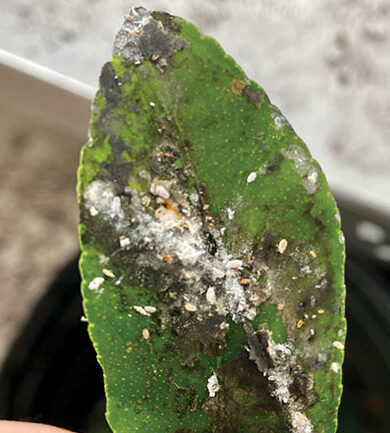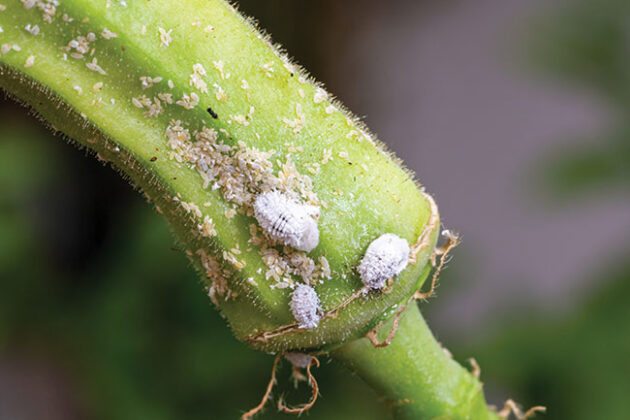
Features
Mealybug management
Strategies for effective control in greenhouses
February 19, 2024 By Jaden Gimondo, Michigan State University Extension and Raymond Cloyd, Kansas State University
 Mealybug damage on a citrus leaf.
Photo: © Samantha Locking / iStock / Getty Images Plus
Mealybug damage on a citrus leaf.
Photo: © Samantha Locking / iStock / Getty Images Plus Mealybugs are a common insect pest in greenhouses, causing damage to plants and reducing yields. Mealybugs extract plant fluids through their piercing-sucking mouthparts, leading to stunted growth, yellowing leaves, wilting, and the production of sticky honeydew. Mealybugs can be introduced into greenhouses through tropical, foliage, and succulent plant material shipments, making effective control strategies important. A combination of cultural, insecticidal, and biological management strategies need to be implemented to manage mealybug populations.
Identifying mealybugs is relatively easy due to their elliptical shape and distinctive white, waxy filaments protruding from their body. While they retain their legs in all instar stages, mealybugs seldom move except for the first nymphal instar stage or crawler, which actively searches for a place to feed. Some species leave behind white, cottony egg masses and excrete honeydew, which can lead to the growth of black sooty mold. Their ability to hide in plant crevasses makes them particularly difficult to manage. Since only adult male mealybugs fly, yellow sticky cards are not effective for scouting. Therefore, using a hand lens or magnifying glass to confirm the identity of mealybugs is recommended. Keeping records of mealybug infestations and location will help in making effective management decisions.
Disposal and quarantining
One of the most effective ways to stop the spread of mealybugs in the greenhouse is to dispose of heavily infested plant material. Setting up pest thresholds in your operation is important to determine when to cut your losses and throw away plant material. A pest threshold is the level at which a pest population in a crop reaches the point where it begins to cause economic losses. In other words, it is the point at which the cost of controlling the pest exceeds the cost of the damage it causes to the crop. Determining a pest threshold requires a comprehensive assessment of the crop, pest, economic factors, and the availability and effectiveness of management options.Plant material susceptible to mealybugs should be quarantined before introducing into the greenhouse. For high-value crops where disposal is not ideal, quarantining infested plants helps ensure mealybugs do not spread to unaffected plants. Quarantine protocols will be different depending on the size of the operation and the crop type, but the basic steps include the following:
- Isolation: Place new plants in a separate area, away from the main greenhouse, to prevent the spread of mealybugs to other plants. This could be an area as large as a greenhouse or as small as a grow tent.
- Inspection: Before bringing new plants into the greenhouse, inspect them thoroughly for mealybugs, focusing on growing tips and areas where the leaf attaches to the stem.
- Prevention: Rejecting the shipment and contacting the supplier may be necessary.
- Treatment: If mealybugs are found on new plants, treat plants with an insecticide before introducing them into the greenhouse. Thorough coverage of all plant parts is important and multiple applications will be required.
- Monitoring: Regularly inspect quarantined plants for mealybugs and treat with an insecticide as needed.
- Record keeping: Record when and where mealybugs are found, severity of the infestation, and any insecticides applied. Record-keeping will help determine the effectiveness of the quarantine measures.

Before bringing new plants into the greenhouse, inspect them thoroughly for mealybugs, focusing on growing tips and areas where the leaf attaches to the stem.
Photo: © kckate16 / iStock / Getty Images Plus
Sanitation
Proper greenhouse sanitation is crucial to mitigate the spread of mealybugs. It is important to keep greenhouses clean. Doing so will help to minimize mealybug problems before the spring growing season begins.
The first step in greenhouse sanitation is to remove all plant debris. Weeds, plant debris, and unsalable plants can serve as hosts for insects, mites, diseases, and plant viruses. Remove all weeds and plant debris and place them into a tightly sealed, covered garbage container to prevent pests and pathogens from migrating out and back onto the main crop. Remember to remove organic material and debris (media, spent plants, other organic material) daily, to increase the effectiveness of disinfectants.
Mealybugs are easily spread in a greenhouse. Therefore, educating employees/workers on the importance of sanitation practices is important. Workers should be trained to identify signs of mealybug infestations on plants and the areas in the greenhouse where mealybugs are commonly located to prevent infestations from spreading. It is also important to remind workers to wash their hands frequently and disinfect, not only tools and equipment, but also any containers, trays, or other items used to transport plants. By taking these measures, workers can help reduce the risk of spreading mealybugs in a greenhouse.
Pesticide control
Due to their protective waxy covering, mealybugs can be challenging to manage with insecticides. The covering is water-resistant and reduces exposure to insecticide residues. Most insecticides have limited activity on mealybug eggs. The nymphal stages are the most susceptible to because they have not formed the waxy covering. Insecticides need to be applied frequently, at least once per week, due to the presence of multiple generations.
When using insecticides to manage mealybug populations be sure to rotate insecticides with different modes of action. This will reduce the likelihood of mealybugs developing resistance. Refer to the Insecticide Resistance Action Committee (IRAC) website on information pertaining to insecticide modes of action.
Biological control?
Biological control agents such as mealybug destroyers (Cryptolaemus montrouzieri) and lacewing larvae (Chrysoperla spp.), can be released to manage mealybug populations.
https://www.canr.msu.edu/news/mealybug-management-in-greenhouses-strategies-for-effective-management
Print this page